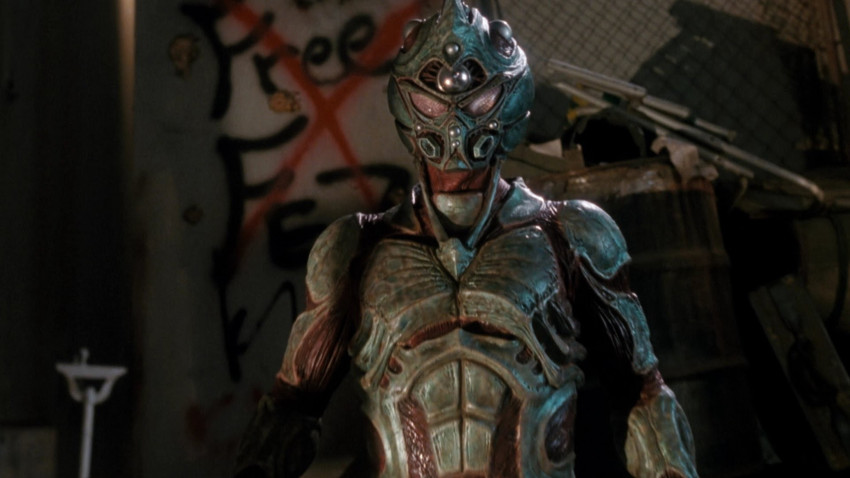The Guyver
December 17, 2016 · 0 comments
by Jeremy Clarke.
 Yoshiki Takaya’s manga The Guyver was published in 1985. It spawned one anime movie Guyver: Out Of Control (1986), two anime serials (in 1989 and 2005) and two low-budget, US live-action movies. The Japanese title literally translates as The Guyver Bio Booster Armour under which moniker the second anime series is known in the West. In the UK the first series was released by fledgeling distributor Manga Entertainment simply as The Guyver, although the words Bio Booster Armour could be seen in very small print on the VHS sleeves. The second series is easy enough to track down and watch since it’s available to stream here on the Funimation site at the time of writing. The two US movies are The Guyver (1991) which is being released on dual format in time for Christmas 2016 and The Guyver: Dark Hero (1994).
Yoshiki Takaya’s manga The Guyver was published in 1985. It spawned one anime movie Guyver: Out Of Control (1986), two anime serials (in 1989 and 2005) and two low-budget, US live-action movies. The Japanese title literally translates as The Guyver Bio Booster Armour under which moniker the second anime series is known in the West. In the UK the first series was released by fledgeling distributor Manga Entertainment simply as The Guyver, although the words Bio Booster Armour could be seen in very small print on the VHS sleeves. The second series is easy enough to track down and watch since it’s available to stream here on the Funimation site at the time of writing. The two US movies are The Guyver (1991) which is being released on dual format in time for Christmas 2016 and The Guyver: Dark Hero (1994).
The first live-action movie The Guyver was a labour of love for its co-directors. Japanese-born Screaming Mad George and Taiwanese-born Steve Wang brought the project to producer Brian Yuzna after working on the effects for the big-budget SF production Predator in which an alien warrior hunts Arnold Schwarzenegger through a Central American jungle. Predator’s hunter alien was the perfect candidate for the human-sized, man-in-a-monster-suit approach to realising a creature on the screen.
 Like Predator, The Guyver features human-sized monsters. The shady, alien-run Chronos corporation turns human beings into monster warriors called Zoanoids. It also makes the Guyver Unit which can be worn as a shield not only by the aliens themselves but also by humans, increasing the latter’s strength a hundred-fold. Risible stuff, but perfect if your concept of cinema is to have actors dress up in monster suits and fight one another. Which is pretty much what this first live-action movie version is all about. For good measure, it throws in eye-popping transformation sequences as characters change from humans into Zoanoids.
Like Predator, The Guyver features human-sized monsters. The shady, alien-run Chronos corporation turns human beings into monster warriors called Zoanoids. It also makes the Guyver Unit which can be worn as a shield not only by the aliens themselves but also by humans, increasing the latter’s strength a hundred-fold. Risible stuff, but perfect if your concept of cinema is to have actors dress up in monster suits and fight one another. Which is pretty much what this first live-action movie version is all about. For good measure, it throws in eye-popping transformation sequences as characters change from humans into Zoanoids.
Four gang members in a transit van track down a research scientist (Greg Joung Paik) who morphs into a biped with an aquatic creature’s head, webbed fingers and fins. The gang leader (Michael Berryman) retaliates by transforming into an huge-jawed biped with lots of large, pointy teeth and bloodily crushes him to death. Flawlessly sculpted though the Zoanoid suits are, cutaway shots of trouser legs ripping as mutating flesh expands into bigger forms were swiftly eclipsed by the ground-breaking computer-generated (CG) transformation sequences in the same year’s big-budget, high-profile Terminator 2: Judgement Day. CG effects were in their infancy in 1991 and appeared in relatively few films, so this was a stroke of bad luck for the production. Jurassic Park would prove the real game-changer in mixing up physical and CG character animation effects a couple of years later.
For The Guyver’s finale in Chronos’ research laboratories, about half a dozen ‘man in suit’ monsters materialise to attack the Guyver and his human companions. These include one with a head sprouting a diminutive elephantine trunk, one with a head sporting floppy bat-like wings, and for the gang’s one female member, one whose head has a bird’s beak and whose body is covered with pink fur. A further creature recalls an allosaurus crossed with a praying mantis. In addition to actors running around in prosthetic suits, a terrific sequence has Mark Hamill mutate into a man-sized beetle. Sadly no discernible plot logic underpins The Guyver’s various creature designs, suggesting little intent in the mind of its directors beyond a desire to play with the visuals for their own sake.
Eventually, Chronos’ corporate boss David Gale transforms into the Zoanoids’ leader, or Zoalord, who resembles an antler-studded dragon bereft of the ability to breathe fire and fitted with insect back legs. Where the other creature effects succeed thanks to the energy of the actors inside them, this final monster lacks the character that might perhaps have been injected into it via other techniques and, in retrospect, pales beside any of the dinosaurs in the stop-frame-influenced Jurassic Park.
Viewing the film today, its main asset is the Guyver itself. The series of shots as actor Jack Armstrong transforms are convincing, particularly the close-up of the unit attached to his head with lots of fibrous tendrils burrowing into his body. Once the Guyver suit has integrated with its human host, the suited Armstrong looks and moves impressively enough in his Aikido-styled fight scenes. A highly effective later human-to-Guyver transformation deploys a series of separate shots in which its constituent parts are slapped on to various areas of the actor’s body . However when he’s not wearing the suit, Armstrong lacks the charisma to carry the proceedings. He was replaced by David Hayter on the second movie.
Notwithstanding serviceable performances by Hamill, Gale, Berryman, Vivian Wu and Jeffrey Coombs as a lab scientist, the proceedings are poorly served by a jokey script presenting Chronos gang members as humorous figures rather than menacing threat. As with the first anime series, the potentially promising material delivers little beyond a visually-arresting Guyver suit design and a series of monsters fighting each other one-on-one. The film was renamed Mutronics for its European release.
George would subsequently work on special effects for a number of films produced or directed by Yuzna notably Society. Wang would go on to direct slightly superior follow up The Guyver: Dark Hero and impressive action thriller Drive. Yuzna continues producing and directing off-beat horror thrillers to this day and can be seen talking about the production in a ten minute interview on the new disc.
The Guyver is released on dual format DVD and Blu-ray by Arrow Video on 19th December 2016.
anime, Brian Yuzna, Funimation, Guyver, Japan, Jeremy Clarke, live-action, manga, Screaming Mad George
Leave a Reply